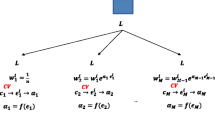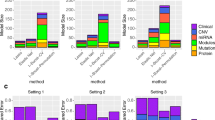Abstract
In biomedical research, boosting-based regression approaches have gained much attention in the last decade. Their intrinsic variable selection procedure and ability to shrink the estimates of the regression coefficients toward 0 make these techniques appropriate to fit prediction models in the case of high-dimensional data, e.g. gene expressions. Their prediction performance, however, highly depends on specific tuning parameters, in particular on the number of boosting iterations to perform. This crucial parameter is usually selected via cross-validation. The cross-validation procedure may highly depend on a completely random component, namely the considered fold partition. We empirically study how much this randomness affects the results of the boosting techniques, in terms of selected predictors and prediction ability of the related models. We use four publicly available data sets related to four different diseases. In these studies, the goal is to predict survival end-points when a large number of continuous candidate predictors are available. We focus on two well known boosting approaches implemented in the R-packages CoxBoost and mboost, assuming the validity of the proportional hazards assumption and the linearity of the effects of the predictors. We show that the variability in selected predictors and prediction ability of the model is reduced by averaging over several repetitions of cross-validation in the selection of the tuning parameters.





Similar content being viewed by others
References
Binder H (2013) CoxBoost: Cox models by likelihood based boosting for a single survival endpoint or competing risks, R package version 1.4. http://CRAN.R-project.org/package=CoxBoost
Binder H, Schumacher M (2008a) Allowing for mandatory covariates in boosting estimation of sparse high-dimensional survival models. BMC Bioinform 9:14
Binder H, Schumacher M (2008b) Adapting prediction error estimates for biased complexity selection in high-dimensional bootstrap samples. Stat Appl Genet Mol Biol 7:12
Boulesteix AL, Richter A, Bernau C (2013) Complexity selection with cross-validation for lasso and sparse partial least squares using high-dimensional data. In: Lausen B, Van den Poel D, Ultsch A (eds) Algorithms from and for nature and life. Springer, Berlin, pp 261–268
Bøvelstad H, Nygård S, Borgan Ø (2009) Survival prediction from clinico-genomic models—a comparative study. BMC Bioinform 10:413
Brier GW (1950) Verification of forecasts expressed in terms of probability. Mon Weather Rev 78:1–3
Bühlmann P (2006) Boosting for high-dimensional linear models. Ann Stat 34:559–583
Bühlmann P, Hothorn T (2007) Boosting algorithms: regularization, prediction and model fitting. Stat Sci 22:477–505
Bühlmann P, Yu B (2003) Boosting with the L\(_2\) loss: regression and classification. J Am Stat Assoc 98:324–339
Chang YCI, Huang Y, Huang YP (2010) Early stopping in \(l_2\) boosting. Comput Stat Data Anal 54:2203–2213
De Bin R (2016) Boosting in Cox regression: a comparison between the likelihood-based and the model-based approaches with focus on the R-packages CoxBoost and mboost. Comput Stat 31:513–531
De Bin R, Herold T, Boulesteix AL (2014a) Added predictive value of omics data: specific issues related to validation illustrated by two case studies. BMC Med Res Methodol 14:117
De Bin R, Sauerbrei W, Boulesteix AL (2014b) Investigating the prediction ability of survival models based on both clinical and omics data: two case studies. Stat Med 33:5310–5329
Efron B, Hastie T, Johnstone I, Tibshirani R (2004) Least angle regression. Ann Stat 32:407–499
Freund Y, Schapire R (1996) Experiments with a new boosting algorithm. In: Proceedings of the 13th international conference on machine learning. Morgan Kaufmann, pp 148–156
Friedman JH (2001) Greedy function approximation: a gradient boosting machine. Ann Stat 29:1189–1232
Fuchs M, Hornung R, De Bin R, Boulesteix, AL (2013) A U-statistic estimator for the variance of resampling-based error estimators. Technical Report 148, University of Munich
Gerds TA, Schumacher M (2006) Consistent estimation of the expected brier score in general survival models with right-censored event times. Biom J 48(6):1029–1040
Graf E, Schmoor C, Sauerbrei W, Schumacher M (1999) Assessment and comparison of prognostic classification schemes for survival data. Stat Med 18:2529–2545
Hastie T, Tibshirani R, Friedman J (2001) The elements of statistical learning: data mining, inference and prediction. Springer, New York
Hatzis C, Pusztai L, Valero V, Booser DJ, Esserman L, Lluch A, Vidaurre T, Holmes F, Souchon E, Wang H et al (2011) A genomic predictor of response and survival following taxane–anthracycline chemotherapy for invasive breast cancer. J Am Med Assoc 305(18):1873
Hofner B, Mayr A, Robinzonov N, Schmid M (2014) Model-based boosting in R: a hands-on tutorial using the R package mboost. Comput Stat 29:3–35
Hothorn T, Bühlmann P, Dudoit S, Molinaro A, Van Der Laan MJ (2006) Survival ensembles. Biostatistics 7:355–373
Hothorn T, Buehlmann P, Kneib T, Schmid M, Hofner B (2015) mboost: model-based boosting, R package version 2.4-2. http://CRAN.R-project.org/package=mboost
Kohavi R (1995) A study of cross-validation and bootstrap for accuracy estimation and model selection. In: Proceedings of international joint conference on artificial intelligence, pp 1137–1145
Mayr A, Hofner B, Schmid M (2012) The importance of knowing when to stop. A sequential stopping rule for component-wise gradient boosting. Methods Inf Med 51:178–186
Mayr A, Binder H, Gefeller O, Schmid M (2014a) Extending statistical boosting. Methods Inf Med 53:428–435
Mayr A, Binder H, Gefeller O, Schmid M (2014b) The evolution of boosting algorithms. Methods Inf Med 53:419–427
Metzeler KH, Hummel M, Bloomfield CD, Spiekermann K, Braess J, Sauerland MC, Heinecke A, Radmacher M, Marcucci G, Whitman SP et al (2008) An 86-probe-set gene-expression signature predicts survival in cytogenetically normal acute myeloid leukemia. Blood 112(10):4193–4201
Mogensen UB, Ishwaran H, Gerds TA (2012) Evaluating random forests for survival analysis using prediction error curves. J Stat Soft 50(11):1–23
Oberthuer A, Kaderali L, Kahlert Y, Hero B, Westermann F, Berthold F, Brors B, Eils R, Fischer M (2008) Subclassification and individual survival time prediction from gene expression data of neuroblastoma patients by using caspar. Clin Cancer Res 14(20):6590–6601
Ridgeway G (1999) Generalization of boosting algorithms and applications of Bayesian inference for massive datasets. PhD thesis, University of Washington
Rosenwald A, Wright G, Chan WC, Connors JM, Campo E, Fisher RI, Gascoyne RD, Muller-Hermelink HK, Smeland EB, Giltnane JM et al (2002) The use of molecular profiling to predict survival after chemotherapy for diffuse large-b-cell lymphoma. N Engl J Med 346(25):1937–1947
Schmid M, Hothorn T (2008) Flexible boosting of accelerated failure time models. BMC Bioinform 9:269
Schumacher M, Binder H, Gerds T (2007) Assessment of survival prediction models based on microarray data. Bioinformatics 23:1768–1774
Tutz G, Binder H (2006) Generalized additive modeling with implicit variable selection by likelihood-based boosting. Biometrics 62:961–971
Verweij PJ, Van Houwelingen HC (1993) Cross-validation in survival analysis. Stat Med 12:2305–2314
Acknowledgements
We thank Rory Wilson and Jenny Lee for language improvements. HS and RDB were supported by Grants BO3139/4-1, BO3139/4-2 and BO3139/2-3 to ALB from the German Research Foundation (DFG).
Author information
Authors and Affiliations
Corresponding author
Electronic supplementary material
Below is the link to the electronic supplementary material.
Rights and permissions
About this article
Cite this article
Seibold, H., Bernau, C., Boulesteix, AL. et al. On the choice and influence of the number of boosting steps for high-dimensional linear Cox-models. Comput Stat 33, 1195–1215 (2018). https://doi.org/10.1007/s00180-017-0773-8
Received:
Accepted:
Published:
Issue Date:
DOI: https://doi.org/10.1007/s00180-017-0773-8




